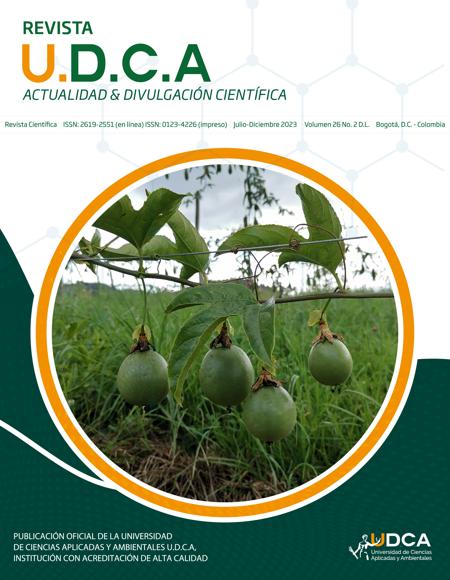Diversidad microbiana en estudios de fertilización mineral de larga duración en caña de azúcar
Microbial diversity in studies of long-term mineral fertilization studies in sugarcane
Contenido principal del artículo
Resumen
Las comunidades microbianas son esenciales para la productividad de los agroecosistemas. En caña de azúcar, el uso de fertilizantes nitrogenados, como práctica de manejo común, mantiene los niveles de la productividad del cultivo e influye en la diversificación del microbioma, ocasionando cambios en la diversidad de los microorganismos involucrados en el ciclo del nitrógeno (N). El objetivo de este estudio consistió en analizar la influencia de diferentes regímenes de fertilización nitrogenada sobre la estructura y la composición de la comunidad microbiana rizosférica, en un experimento de larga duración. Esta investigación permitirá establecer un régimen de fertilización más preciso. Se demostró que no existen diferencias significativas en la composición y en la estructura de la comunidad bacteriana, al usar diferentes niveles de fertilización nitrogenada en caña de azúcar. Los Phylum Acidobacteria, Firmicutes y Mortierellomycota fueron los más relacionados con las dosis de nitrógeno recomendadas, para obtener altos rendimientos agrícolas, bajo las condiciones de Cuba; sin embargo, existieron variaciones en cuanto a composición y abundancias relativas de los Phylum de la micobiota respecto a las dosis de nitrógeno aplicadas, con predominio de los Phylum Ascomycota y Basidiomycota. Fueron detectadas diferencias significativas, a nivel de género y familia, debido a la presencia de organismos probióticos en las parcelas no tratadas.
Palabras clave:
Descargas
Datos de publicación
Perfil evaluadores/as N/D
Declaraciones de autoría
- Sociedad académica
- Universidad de Ciencias Aplicadas UDCA
- Editorial
- Universidad de Ciencias Aplicadas y Ambientales U.D.C.A
Detalles del artículo
Referencias (VER)
ANDERSON, M.J. 2001. A New method for non-parametric multivariate analysis of variance. Austral Ecology. 26(1):32-46. https://onlinelibrary.wiley.com/doi/10.1111/j.1442-9993.2001.01070.pp.x. DOI: https://doi.org/10.1111/j.1442-9993.2001.01070.pp.x
BAHADORI, M.; WANG, J.T.; SHEN, J.P.; LEWIS, S.; REZAEI RASHTI, M.; CHEN, C.H. 2022. Soil organic matter and geochemical characteristics shape microbial community composition and structure across different land uses in an Australian wet tropical catchment. Land degradation & development. Reino Unido. 33(6):817-831. https://doi.org/10.1002/ldr.4174 DOI: https://doi.org/10.1002/ldr.4174
BAHRAM, M.; HILDEBRAND, F.; FORSLUND, S.; ANDERSON, J.; SOUDZILOVSKAIA, N.; BODEGOM, P.; BENGTSSON-PALME, J.; ANSLAN, S.; COELHO, L.P.; HAREND, H.; HUERTA-CEPAS, J.; MEDEMA, M.H.; MALTZ, M.R.; MUNDRA, S.; OLSSON, P.A.; PENT, M.; PÕLME, S.; SUNAGAWA, S.; RYBERG, M.; TEDERSOO, L.; BORK, P. 2018. Structure and function of the global topsoil microbiome. Nature. 560(7717):233-237. https://doi.org/10.1038/s41586-018-0386-6 DOI: https://doi.org/10.1038/s41586-018-0386-6
BRENNER, D.J.; KRIEG, N.R.; STALEY, J.T. 2005. Bergey’s manual® of systematic bacteriology. Volume two: The roteobacteria (Part C). 2nd ed. Springer. US. DOI: https://doi.org/10.1007/0-387-29298-5
BRIGHT, J.P.; KARUNANADHAM, K.; MAHESHWARI, H.S.; KARUPPIAH, E.A.A.; THANKAPPAN, S.; NATARAJ, R.; PANDIAN, D.; AMEEN, F.; POCZAI, P.; SAYYED, R.Z. 2022. Seed-borne probiotic yeasts foster plant growth and elicit health protection in black gram (Vigna mungo L.). Sustainability. Suiza. 14:e4618. https://doi.org/10.3390/su14084618 DOI: https://doi.org/10.3390/su14084618
BUDDIWONG, S.; THANONKEO, S.; PHETSOM, J.; JAISIL, P.; THANONKEO, P. 2014. Screening of thermotolerant yeast isolated from sugarcane plantations in Northeastern part of Thailand. KHON KAEN University Research Journal. 19(Supl. 1):217-223.
CALLAHAN, B.J.; MCMURDIE, P.J.; ROSEN, M.J.; HAN, A.W.; JOHNSON, A.J.A.; HOLMES, S.P. 2016. DADA2: High-Resolution Sample Inference from Illumina Amplicon Data. Nature Methods. 13(7):581-83. https://doi.org/10.1038/nmeth.3869 DOI: https://doi.org/10.1038/nmeth.3869
CENTENO-MARTÍNEZ, R.E.; MOHAN, S.; DAVIDSON, J.L.; SCHOONMAKER, J.P.; AULT, A.; VERMA M.S.; JOHNSON, T.A. 2023. The bovine nasal fungal community and associations with bovine respiratory disease. Frontiers in Veterinary Science. Suiza 10:1165994. https://doi.org/10.3389/fvets.2023.1165994 DOI: https://doi.org/10.3389/fvets.2023.1165994
CORDOVEZ, V.; SCHOP, S.; HORDIJK, K.; DE BOULOIS, H.D.; COPPENS, F.; HANSSEN, I.; RAAIJMAKERS, J.M.; CARRIÓN, V.J. 2018. Priming of plant growth promotion by volatiles of root associated Microbacterium spp. Applied. Environmental. Microbiology. Estados Unidos. p.84 https://doi.org/10.1128/AEM.01865-18 DOI: https://doi.org/10.1128/AEM.01865-18
CORSARO, D.; WALOCHNIK, J.; VENDITTI, D.; STEINMANN, J.; MÜLLER, K.D.; MICHEL, R. 2014. Microsporidia-like parasites of amoebae belong to the early fungal lineage Rozellomycota. Parasitology Research. 113(5):1909-18. https://doi.org/10.1007/s00436-014-3838-4 DOI: https://doi.org/10.1007/s00436-014-3838-4
DE CHAVES, M.G.; SILVA, G.G.Z.; ROSSETTO, R.; EDWARDS, R.A.; TSAI S.M.; NAVARRETE, A.A. 2019. Subgrupos de acidobacterias y su potencial metabólico para la degradación del carbono en suelos de caña de azúcar modificados con vinaza y fertilizantes nitrogenados. Frente. Microbiology. Suiza. 10:1680. https://doi.org/10.3389/fmicb.2019.01680 DOI: https://doi.org/10.3389/fmicb.2019.01680
DE LEÓN, M.; PÉREZ, H.; VILLEGAS, R.; PÉREZ, H.; SANTANA, I.; RODRÍGUEZ, I. 2013. Manejo sostenible de tierras en la producción de caña de azúcar. grupo azucarero AZCUBA. Instituto de Investigaciones de la Caña de Azúcar. p.71-77
EDWARDS, J.; JOHNSON, C.; SANTOS-MEDELLÍN, C.; LURIE E.; PODISHETTY, N.K.; EISEN, J.A.; SUNDARESAN. 2015. Structure, Variation, and Assembly of the Root-Associated Microbiomes of Rice. Proceedings of the National Academy of Sciences of the United States of America Estados Unidos.112(8):e911-20. https://doi.org/10.1073/pnas.1414592112 DOI: https://doi.org/10.1073/pnas.1414592112
FENG, Y.; DELGADO-BAQUERIZO, M.; ZHU, Y.; HAN, X.; HAN, X.; XIN, X.; LI, W.; GUO, Z.; DANG, T.; LI, C. 2022. Responses of soil bacterial diversity to fertilization are driven by local environmental context across China. Engineering. 12:164-170. https://doi.org/10.1016/j.eng.2021.09.012 DOI: https://doi.org/10.1016/j.eng.2021.09.012
GOODFELLOW, M.; KÄMPFER, P.; BUSSE, H.J.; TRUJILLO, M.E.; SUZUKI, K.I.; LUDWIG, W.; WHITMAN, W.B. 2009. Bergey’s manual of systematic bacteriology. Volume 5: The Actinobacteria. 2nd ed. Springer. https://doi.org/10.1007/978-0-387-68233-4 DOI: https://doi.org/10.1007/978-0-387-68233-4
GRZĄDZIEL, J.; GAŁĄZKA, A. 2019. Fungal biodiversity of the most common types of polish soil in a long-term microplot experiment. Front. Microbiology. 10:(6). https://doi.org/10.3389/fmicb.2019.00006 DOI: https://doi.org/10.3389/fmicb.2019.00006
GU, Y.; WANG, J.; CAI, W.; LI, G.; MEI; YANG, S. 2021. Different amounts of nitrogen fertilizer applications alter the bacterial diversity and community structure in the rhizosphere soil of sugarcane. Front. Microbiology. 12:e721441. https://doi.org/10.3389/fmicb.2021.721441 DOI: https://doi.org/10.3389/fmicb.2021.721441
HERNÁNDEZ, A.; PÉREZ, J.; BOSCH, D.; CASTRO, N. 1999. Clasificación de los suelos de Cuba. Instituto Nacional de Ciencias Agrícolas e Instituto de Suelos. Mayabeque, Cuba. p.91
HUANG, W.; LU, Y.; CHEN, L.; SUN, D.; AN, Y. 2021. Impact of pesticide/fertilizer mixtures on the rhizosphere microbial community of field-grown sugarcane. 3 Biotech. 11(5):210. https://doi.org/10.1007/s13205-021-02770-3 DOI: https://doi.org/10.1007/s13205-021-02770-3
INSTITUCIÓN DE INVESTIGACIONES DE LA CAÑA DE AZÚCAR, INICA. 1990. Normas metodológicas del departamento de suelos y agroquímica. Tomo 1. p.100.
KATOH, K.; STANDLEY, D.M. 2013. MAFFT multiple sequence alignment software version 7: Improvements in performance and usability. Molecular Biology and Evolution. 30(4):772-80. https://doi.org/10.1093/molbev/mst010 DOI: https://doi.org/10.1093/molbev/mst010
KEARNS, P.J.; ANGELL, J.H.; HOWARD, E.M.; DEEGAN, L.A.; STANLEY, R.H.; BOWEN, J.L. 2016. Nutrient enrichment induces dormancy and decreases diversity of active bacteria in salt marsh sediments. Nature Communications. 7:e12881. https://doi.org/10.1038/ncomms12881 DOI: https://doi.org/10.1038/ncomms12881
KLINDWORTH, A.; PRUESSE, E.; SCHWEER, T.; PEPLIES, J.; QUAST, C.; HORN, M.; GLÖCKNER, F.O. 2013. Evaluation of general 16S ribosomal RNA gene PCR primers for classical and next-generation sequencing-based diversity studies. Nucleic acids research. 41(1):1 https://doi.org/10.1093/nar/gks808 DOI: https://doi.org/10.1093/nar/gks808
KRIEG, N.; STALEY, J.T.; BROWN, D.R.; HEDLUND, B.P.; PASTER, B.J.; WARD, N.L.; LUDWIG, W.; WHITMAN, W.B. 2010. Bergey’s manual of systematic bacteriology Volume 4: The Bacteroidetes, Spirochaetes, Tenericutes (Mollicutes), Acidobacteria, Fibrobacteres, Fusobacteria, Dictyoglomi, Gemmatimonadetes, Lentisphaerae, Verrucomicrobia, Chlamydiae, and Planctomycetes. 2nd ed. Springer. https://doi.org/10.1007/978-0-387-68572-4 DOI: https://doi.org/10.1007/978-0-387-68572-4
LARA ACOSTA, D.; COSTALES MENÉNDEZ, D.; FALCÓN RODRÍGUEZ, A. 2018. Los oligogalacturónidos en el crecimiento y desarrollo de las plantas. Cultivos Tropicales. 39 (2):127-134.
LI, C.X.; MA, S.C.; SHAO, Y.; MA, S.T.; ZHANG, L.L. 2018. Effects of long-term organic fertilization on soil microbiologic characteristics, yield and sustainable production of winter wheat. Journla of Integrative Agriculture. 17:210-219. https://doi.org/10.1016/S2095-3119(17)61740-4 DOI: https://doi.org/10.1016/S2095-3119(17)61740-4
LIN, Y.; YE, G.; LUO, J.; DI, H.J.; LINDSEY, S.; FAN, J.; LIU, D.; DING, W. 2021. Long-term organic fertilization regulates the abundance of major nitrogen-cycling-related genes in aggregates from an acidic Ultisol. ApplIED Soil Ecology. 165:e104014. https://doi.org/10.1016/j.apsoil.2021.104014 DOI: https://doi.org/10.1016/j.apsoil.2021.104014
LIU, X.; LI, Q.; LI, Y.; GUAN, G.; CHEN, S. 2019. Paenibacillus strains with nitrogen fixation and multiple beneficial properties for promoting plant growth. PeerJ. 7:e7445. https://doi.org/10.7717/peerj.7445 DOI: https://doi.org/10.7717/peerj.7445
MARIN, I. 2014. Proteobacteria. En: Amils, R. (ed.) Encyclopedia of astrobiology. Springer. https://doi.org/10.1007/978-3-642-27833-4_1288-2 DOI: https://doi.org/10.1007/978-3-642-27833-4_1288-2
MATSUSHIKA, A.; NEGI, K.; SUZUKI, T.; GOSHIMA, T.; HOSHINO, T. 2016. Identification and characterization of a novel Issatchenkia orientalis GPI-Anchored protein, IoGas1, required for resistance to low pH and salt stress. PLoS One. 11(9):e0161888. https://doi.org/10.1371/journal.pone.0161888 DOI: https://doi.org/10.1371/journal.pone.0161888
MCMURDIE, P.J.; HOLMES, S. 2013. Phyloseq and R package for reproducible interactive analysis and graphics of microbiome census data. PLoS One. 8(4):e61217. https://doi.org/10.1371/journal.pone.0061217 DOI: https://doi.org/10.1371/journal.pone.0061217
MEGYES, M.; BORSODI, A.K.; ÁRENDÁS, T.; MÁRIALIGETI, K. 2021. Variations in the diversity of soil bacterial and archaeal communities in response to different long-term fertilization regimes in maize fields. Applied Soil Ecology. 168:e104120. https://doi.org/10.1016/j.apsoil.2021.104120 DOI: https://doi.org/10.1016/j.apsoil.2021.104120
OKSANEN, J.; KINDT, P.; LEGENDRE, P.; O’HARA, B.; SIMPSON, G.L.; SOLYMOS, P.; H. STEVENS, H.H.; WAGNER, H. 2007. The vegan package. community ecology.
ORGIAZZI, A.; LUMINI, E.; NILSSON, R.H.; GIRLANDA, M.; VIZZINI, A.; BONFANTE, P.; VALERIA, B. 2012. Unravelling soil fungal communities from different mediterranean land-use backgrounds. PLoS ONE Estados Unidos. 7(4):e34847. https://doi.org/10.1371/journal.pone.0034847 DOI: https://doi.org/10.1371/journal.pone.0034847
PATEL, C.B.; SINGH, V.K.; SINGH, A.P.; MEENA, M.; MUPADHYAY, R.S.S. 2019. Chapter 10 - Microbial genes involved in interaction with plants. En: Singh, H.B.; Gupta, V.K.; Jogaiah, S. New and future developments in microbial biotechnology and bioengineering. Microbial Genes Biochemistry and Applications. Elsevier. p.171-180. https://doi.org/10.1016/B978-0-444-63503-7.00010-3 DOI: https://doi.org/10.1016/B978-0-444-63503-7.00010-3
PAUNGFOO-LONHIENNE, C.; YUN KIT, Y.; PINAKI KASINADHUNI, N.R.; LONHIENNE, T.G.A.; ROBINSON, N.; HUGENHOLTZ, P.; RAGAN, M.A.; SUSANNE, S. 2015. Nitrogen fertilizer dose alters fungal communities in sugarcane soil and rhizosphere. Scientific Reports. 5(1):8678. https://doi.org/007810.1038/srep08678 DOI: https://doi.org/10.1038/srep08678
PEDRINHO, E.A.N.; NAVARRETE, A.A.; KISHI, L.T.; CESÁRIO, C.; ROMANCINI, V.; FÉLIX, R.C.; DE SOUZA, E.; NASCIMENTO, L.; MUI, S., DE MACEDO, E.L. 2021. Taxonomic and nitrogen-cycling microbial community functional profiles of sugarcne and adjacent forest soils in Southeast Brazil. MOJ Eco-Environment Sciencie. 6(4):119-125. https://doi.org/10.15406/mojes.2021.06.00224 DOI: https://doi.org/10.15406/mojes.2021.06.00224
PESTER, M.; MAIXNER, F.; BERRY, D.; RATTEI, T.; KOCH, H.; LÜCKER, S.; NOWKA, B.; RICHTER, A.; SPIECK, E.; LEBEDEVA, E.; LOY, A.; WAGNER, M.; DAIMS, H. 2013. Nxr Bencoding the beta subunit of nitrite oxidoreductase as functional and phylogenetic marker for nitrite-oxidizing Nitrospira. Environmental Microbiology. 16(10):3055-3071. https://doi.org/10.1111/1462-2920.12300 DOI: https://doi.org/10.1111/1462-2920.12300
PRICE, M.N.; DEHAL, P.S.; ARKIN, A.P. 2010. FastTree 2: árboles de probabilidad máxima aproximada para alineaciones grandes. PLoS ONE. 5(3):9490. https://doi.org/10.1371/journal.pone.0009490 DOI: https://doi.org/10.1371/journal.pone.0009490
PUZNIAK, O.; HRYNCHYSHYN, N.; DATSKO, T.; ANDRUSZCZAK, S.; HULKO, B. 2022.Consequences of the long-term fertilization system use on physical and microbiological soil status in the Western Polissia of Ukraine. Agriculture. 12:1955. https://doi.org/10.3390/agriculture12111955 DOI: https://doi.org/10.3390/agriculture12111955
RASHID, M.I.; MUJAWAR, L.H.; SHAHZAD, T.; ALMEELBI, T.; ISMAIL, I.M.I.; OVES, M. 2016. Bacteria and fungi can contribute to nutrients bioavailability and aggregate formation in degraded soils. Microbiology Research. 183:26-41. DOI: https://doi.org/10.1016/j.micres.2015.11.007
RUSSO, S.E.; LEGGE, R.; WEBER, K.; BRODIE, E.L.; GOLDFARB, K.C.; BENSON, A.K.; TAN, S. 2012 Bacterial community structure of contrasting soils underlying Bornean rain forests: inferences from microarray and next-generation sequencing methods. Soil Biology and Biochemistry. 55:48-59. https://doi.org/10.1016/j.soilbio.2012.05.021 DOI: https://doi.org/10.1016/j.soilbio.2012.05.021
SHRESTHA, P.; SZARO, T.M.; BRUNS, T.D.; TAYLOR, J.W. 2011. Systematic search for cultivatable fungi that best deconstruct cell walls of miscanthus and sugarcane in the field. Applied and Environmental Microbiology. 77(15):5490-5504. https://doi.org/10.1128/AEM.02996-10 DOI: https://doi.org/10.1128/AEM.02996-10
STEFANINI, I. 2018. Yeast‐insect associations: It takes guts. Yeast. 35(4):315-330. https://doi.org/10.1002/yea.3309 DOI: https://doi.org/10.1002/yea.3309
SUN, Q.; L.I, J.; FINLAY, R.D; LIAN, B. 2019. Oxalotrophic bacterial assemblage in the ectomycorrhizosphere of forest trees and their effects on oxalate degradation and carbon fixation potential. Chemical Geology. 514:54-64. https://doi.org/10.1016/j.chemgeo.2019.03.023 DOI: https://doi.org/10.1016/j.chemgeo.2019.03.023
TEDERSOO, L.; ANSLAN, S.; BAHRAM, M.; PÕLME, S.; RIIT, T.; LIIV, I.; KÕLJALG, U.; KISAND, V.; NILSSON, R.H.; HILDEBRAND, F.; BORK, P.; ABARENKOV, K. 2015 Shotgun metagenomes and multiple primer pair-barcode combinations of amplicons reveal biases in metabarcoding analyses of fungi. MycoKeys. 10:1-43. https://doi.org/10.3897/mycokeys.10.4852 DOI: https://doi.org/10.3897/mycokeys.10.4852
TEDERSOO, L.; LIIV, I.; KIVISTIK, P.A.; ANSLAN, S.; KÕLJALG, U.; BAHRAM, M. 2016. Genomics and metagenomics technologies to recover ribosomal DNA and single-copy genes from old fruit-body and ectomycorrhizal specimens. MycoKeys. 13:1-20. https://doi.org/10.3897/mycokeys.13.8140 DOI: https://doi.org/10.3897/mycokeys.13.8140
VAISHNAV, A.; SINGH, J.; SINGH P.; RAJPUT, R.S.; SINGH, H.B.; SARMA, B.K. 2020. Sphingobacterium sp. BHU-AV3 induces salt tolerance in tomato by enhancing antioxidant activities and energy metabolism. Frontiers Microbioly. 11. https://doi.org/10.3389/fmicb.2020.00443 DOI: https://doi.org/10.3389/fmicb.2020.00443
WALDROP, M.P.; ZAK, D.R. 2006. Response of oxidative enzyme activities to nitrogen deposition affects soil concentrations of dissolved organic carbon. Ecosystems. 9:921-33. https://doi.org/10.1007/s10021-004-0149-0 DOI: https://doi.org/10.1007/s10021-004-0149-0
WANG, Q.; CHEN, L.; HE, L.Y.; SHENG, X.F. 2016. Increased biomass and reduced heavy metal accumulation of edible tissues of vegetable crops in the presence of plant growth-promoting Neorhizobium huautlense T1-17 and biochar. Agriculture, Ecosystem & Environmental. 228:9-18. https://doi.org/10.1016/j.agee.2016.05.006 DOI: https://doi.org/10.1016/j.agee.2016.05.006
WANG, S.; CHENG, J.; LI, T.; LIAO, Y. 2020. Response of soil fungal communities to continuous cropping of flue‑cured tobacco. Scientific Reports. 10:19911. https://doi.org/10.1038/s41598-020-77044-8 DOI: https://doi.org/10.1038/s41598-020-77044-8
WANG, Z.; SOLANKI, M.K.; YU, Z.X.; ANAS, M.; DONG, D.F.; XING, Y.X.; MALVIYA, M.K.; PANG, F.; LI, Y.R. 2021. Genome characteristics reveal the biocontrol potential of Actinobacteria isolated from sugarcane rhizosphere. Frontiers Microbiology. 12:797889. https://doi.org/10.3389/fmicb.2021.797889 DOI: https://doi.org/10.3389/fmicb.2021.797889
YAKHIN, O.I.; LUBYANOV, A.A.; YAKHIN, I.A.; BROWN, P.H. 2017. Biostimulants in plant science: a global perspective. Frontiers in Plant Science. 7. https://doi.org/10.3389/fpls.2016.02049 DOI: https://doi.org/10.3389/fpls.2016.02049
ZHANG, W.; MA, Y.; YANG, X.; XU, X.; NI, B.; LIU, R.; MENG, F. 2023. Investigation of soil microbial communities involved in N cycling as affected by the long-term use of the N stabilizers DMPP and NBPT. Agronomy. 13(3):659. https://doi.org/10.3390/agronomy13030659 DOI: https://doi.org/10.3390/agronomy13030659
ZULLO, B.A.; CIAFARDINI, G. 2020. Virgin olive oil quality is affected by the microbiota that comprise the biotic fraction of the oil. Microorganisms. 8(5):663. https://doi.org/10.3390/microorganisms8050663 DOI: https://doi.org/10.3390/microorganisms8050663







